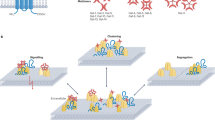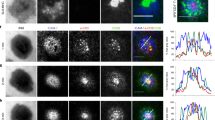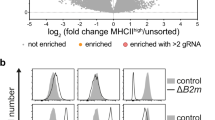Abstract
Lymphocyte antigen receptors are responsible for inducing the opposite responses of immunity or tolerance. How the correct polarity of antigen receptor signaling is encoded has been an enduring enigma. Here we summarize recent advances defining key scaffolding molecules, CARMA1 (also known as CARD11) and the Cbl family of ubiquitin ligases, required for either immunogenic or tolerogenic signaling by antigen receptors. These scaffolding proteins may determine the polarity of response to antigen by promoting assembly around antigen receptors of competing multiprotein signal complexes: immunosomes versus tolerosomes. Each of the factors that influence immunogenicity or tolerogenicity—stage of lymphocyte differentiation, concurrent engagement of inhibitory or costimulatory receptors, extent of receptor crosslinking, and prior antigen experience—may be integrated in lymphocytes through their capacity to influence the probability of assembling immunosomes versus tolerosomes.
This is a preview of subscription content, access via your institution
Access options
Subscribe to this journal
Receive 12 print issues and online access
$209.00 per year
only $17.42 per issue
Buy this article
- Purchase on Springer Link
- Instant access to full article PDF
Prices may be subject to local taxes which are calculated during checkout




Similar content being viewed by others
References
Burnet, F.M. The Clonal Selection Theory of Acquired Immunity (Vanderbilt University Press, Nashville, 1959).
Bouillet, P. et al. BH3-only Bcl-2 family member Bim is required for apoptosis of autoreactive thymocytes. Nature 415, 922–926 (2002).
Burnet, F.M., Stone, J.D. & Edney, M. The failure of antibody production in the chick embryo. Aust. J. Exp. Biol. Med. Sci. 28, 291–297 (1950).
Nossal, G.J.V. The immunological response of foetal mice to influenza virus. Austral. J. Exp. Biol. 35, 549–558 (1957).
Buchmeier, M.J., Welsh, R.M., Dutko, F.J. & Oldstone, M.B. The virology and immunobiology of lymphocytic choriomeningitis virus infection. Adv. Immunol. 30, 275–331 (1980).
Goodnow, C.C. Balancing immunity and tolerance: deleting and tuning lymphocyte repertoires. Proc. Natl. Acad. Sci. USA 93, 2264–2271 (1996).
Burnet, F.M. & Fenner, F. The Production of Antibodies (Macmillan, Melbourne, 1949).
Baxter, A.G. & Hodgkin, P.D. Activation rules: the two-signal theories of immune activation. Nat. Rev. Immunol. 2, 439–446 (2002).
Dintzis, H.M., Dintzis, R.Z. & Vogelstein, B. Molecular determinants of immunogenicity: the immunon model of immune response. Proc. Natl. Acad. Sci USA 73, 3671–3675 (1976).
Dresser, D.W. & Mitchison, N.A. The mechanism of immunological paralysis. Adv. Immunol. 8, 129–181 (1968).
Grossman, Z. & Paul, W.E. Adaptive cellular interactions in the immune system: the tunable activation threshold and the significance of subthreshold responses. Proc. Natl. Acad. Sci. USA 89, 10365–10369 (1992).
Sheng, M. & Sala, C. PDZ domains and the organization of supramolecular complexes. Annu. Rev. Neurosci. 24, 1–29 (2001).
Fanning, A.S. & Anderson, J.M. Protein modules as organizers of membrane structure. Curr. Opin. Cell Biol. 11, 432–439 (1999).
Crabtree, G.R. Calcium, calcineurin, and the control of transcription. J. Biol. Chem. 276, 2313–2316 (2001).
Healy, J.I. et al. Different nuclear signals are activated by the B cell receptor during positive versus negative signaling. Immunity 6, 419–428 (1997).
Dolmetsch, R.E., Lewis, R.S., Goodnow, C.C. & Healy, J.I. Differential activation of transcription factors induced by Ca2+ response amplitude and duration. Nature 386, 855–858 (1997).
Frantz, B. et al. Calcineurin acts in synergy with PMA to inactivate IκB/MAD3, an inhibitor of NF-kappa B. EMBO J 13, 861–870 (1994).
Gerondakis, S., Grossmann, M., Nakamura, Y., Pohl, T. & Grumont, R. Genetic approaches in mice to understand Rel/NF-κB and IκB function: transgenics and knockouts. Oncogene 18, 6888–6895 (1999).
Peng, S.L., Gerth, A.J., Ranger, A.M. & Glimcher, L.H. NFATc1 and NFATc2 together control both T and B cell activation and differentiation. Immunity 14, 13–20 (2001).
Macian, F. et al. Transcriptional mechanisms underlying lymphocyte tolerance. Cell 109, 719–731 (2002).
Glynne, R. et al. How self-tolerance and the immunosuppressive drug FK506 prevent B-cell mitogenesis. Nature 403, 672–676 (2000).
Youn, H.D., Sun, L., Prywes, R. & Liu, J.O. Apoptosis of T cells mediated by Ca2+-induced release of the transcription factor MEF2. Science 286, 790–793 (1999).
Calnan, B.J., Szychowski, S., Chan, F.K., Cado, D. & Winoto, A. A role for the orphan steroid receptor Nur77 in apoptosis accompanying antigen-induced negative selection. Immunity 3, 273–282 (1995).
Jordan, M.S., Singer, A.L. & Koretzky, G.A. Adaptors as central mediators of signal transduction in immune cells. Nat. Immunol. 4, 110–116 (2003).
Fruman, D.A., Satterthwaite, A.B. & Witte, O.N. Xid-like phenotypes: a B cell signalosome takes shape. Immunity 13, 1–3 (2000).
Werlen, G. & Palmer, E. The T-cell receptor signalosome: a dynamic structure with expanding complexity. Curr. Opin. Immunol. 14, 299–305 (2002).
Kurosaki, T. Regulation of B-cell signal transduction by adaptor proteins. Nat. Rev. Immunol. 2, 354–363 (2002).
Samelson, L.E. Signal transduction mediated by the T cell antigen receptor: the role of adapter proteins. Annu. Rev. Immunol. 20, 371–394 (2002).
Janssen, E., Zhu, M., Zhang, W. & Koonpaew, S. LAB: a new membrane-associated adaptor molecule in B cell activation. Nat. Immunol. 4, 117–123 (2003).
Brdicka, T. et al. Non-T cell activation linker (NTAL): a transmembrane adaptor protein involved in immunoreceptor signaling. J. Exp. Med. 196, 1617–1626 (2002).
Weiss, A. & Schlessinger, J. Switching signals on or off by receptor dimerization. Cell 94, 277–280 (1998).
El-Hillal, O., Kurosaki, T., Yamamura, H., Kinet, J.P. & Scharenberg, A.M. syk kinase activation by a src kinase-initiated activation loop phosphorylation chain reaction. Proc. Natl. Acad. Sci. USA 94, 1919–1924 (1997).
Rolli, V. et al. Amplification of B cell antigen receptor signaling by a Syk/ITAM positive feedback loop. Mol. Cell 10, 1057–1069 (2002).
Reth, M. Hydrogen peroxide as second messenger in lymphocyte activation. Nat. Immunol. 3, 1129–1134 (2002).
Dykstra, M., Cherukuri, A., Sohn, H.W., Tzeng, S.J. & Pierce, S.K. Location is everything: lipid rafts and immune cell signaling. Annu. Rev. Immunol. 21, 457–481 (2003).
Awasthi-Kalia, M., Schnetkamp, P.P. & Deans, J.P. Differential effects of filipin and methyl-beta-cyclodextrin on B cell receptor signaling. Biochem. Biophys. Res. Commun. 287, 77–82 (2001).
Kabouridis, P.S., Janzen, J., Magee, A.L. & Ley, S.C. Cholesterol depletion disrupts lipid rafts and modulates the activity of multiple signaling pathways in T lymphocytes. Eur. J. Immunol. 30, 954–963 (2000).
Pizzo, P. & Viola, A. Lymphocyte lipid rafts: structure and function. Curr. Opin. Immunol. 15, 255–260 (2003).
Horejsi, V. Membrane rafts in immunoreceptor signaling: new doubts, new proofs? Trends Immunol. 23, 562–564 (2002).
Koyasu, S. The role of PI3K in immune cells. Nat. Immunol. 4, 313–319 (2003).
Turner, M. & Billadeau, D.D. VAV proteins as signal integrators for multi-subunit immune-recognition receptors. Nat. Rev. Immunol. 2, 476–486 (2002).
Negishi, I. et al. Essential role for ZAP-70 in both positive and negative selection of thymocytes. Nature 376, 435–438 (1995).
Sommers, C.L. et al. A LAT mutation that inhibits T cell development yet induces lymphoproliferation. Science 296, 2040–2043 (2002).
Li, Q. & Verma, I.M. NF-κB regulation in the immune system. Nat. Rev. Immunol. 2, 725–734 (2002).
Schwartz, R.H. T cell anergy. Annu. Rev. Immunol. 21, 305–334 (2002).
Mondino, A. et al. Defective transcription of the IL-2 gene is associated with impaired expression of c-Fos, FosB, and JunB in anergic T helper 1 cells. J. Immunol. 157, 2048–2057 (1996).
Sundstedt, A. et al. In vivo anergized CD4+ T cells express perturbed AP-1 and NF-κB transcription factors. Proc. Natl. Acad. Sci. USA 93, 979–984 (1996).
Kane, L.P., Lin, J. & Weiss, A. It's all Rel-ative: NF-κB and CD28 costimulation of T-cell activation. Trends Immunol. 23, 413–420 (2002).
Dong, C., Davis, R.J. & Flavell, R.A. MAP kinases in the immune response. Annu. Rev. Immunol. 20, 55–72 (2002).
Golub, E.S. & Weigle, W.O. Studies on the induction of immunologic unresponsiveness. I. Effects of endotoxin and phytochemagglutinin. J. Immunol. 98, 1241–1247 (1967).
Hartley, S.B. et al. Elimination of self-reactive B lymphocytes proceeds in two stages: arrested development and cell death. Cell 72, 325–335 (1993).
Tsubata, T., Wu, J. & Honjo, T. B-cell apoptosis induced by antigen receptor crosslinking is blocked by a T-cell signal through CD40. Nature 364, 645–648 (1993).
Wang, D. et al. A requirement for CARMA1 in TCR-induced NF-κB activation. Nat. Immunol. 3, 830–835 (2002).
Gaide, O. et al. CARMA1 is a critical lipid raft-associated regulator of TCR-induced NF-kappa B activation. Nat. Immunol. 3, 836–843 (2002).
Pomerantz, J.L., Denny, E.M. & Baltimore, D. CARD11 mediates factor-specific activation of NF-κB by the T cell receptor complex. EMBO J. 21, 5184–5194 (2002).
Hara, H. et al. The MAGUK family protein CARD11 is essential for lymphocyte activation. Immunity 18, 763–775 (2003).
Newton, K. & Dixit, V.M. Mice Lacking the CARD of CARMA1 exhibit defective B lymphocyte development and impaired proliferation of their B and T lymphocytes. Curr. Biol. 13, 1247–1251 (2003).
Egawa, T. et al. Requirement for CARMA1 in antigen receptor-induced NF-κB Activation and lymphocyte proliferation. Curr. Biol. 13, 1252–1258 (2003).
Jun, J.E. et al. Identifying the MAGUK protein Carma-1 as a central regulator of humoral immune responses and atopy by genome-wide mouse mutagenesis. Immunity 18, 751–762 (2003).
Dimitratos, S.D., Woods, D.F., Stathakis, D.G. & Bryant, P.J. Signaling pathways are focused at specialized regions of the plasma membrane by scaffolding proteins of the MAGUK family. Bioessays 21, 912–921 (1999).
Mercurio, F. et al. IKK-1 and IKK-2: cytokine-activated IκB kinases essential for NF-kappaB activation. Science 278, 860–866 (1997).
Woronicz, J.D., Gao, X., Cao, Z., Rothe, M. & Goeddel, D.V. IκB kinase-β: NF-κB activation and complex formation with IκB kinase-α and NIK. Science 278, 866–869 (1997).
Ruland, J. et al. Bcl10 is a positive regulator of antigen receptor-induced activation of NF-κB and neural tube closure. Cell 104, 33–42 (2001).
Bertin, J. et al. CARD11 and CARD14 are novel caspase recruitment domain (CARD)/membrane-associated guanylate kinase (MAGUK) family members that interact with BCL10 and activate NF-κB. J. Biol. Chem. 276, 11877–11882 (2001).
Gaide, O. et al. Carma1, a CARD-containing binding partner of Bcl10, induces Bcl10 phosphorylation and NF-κB activation. FEBS Lett. 496, 121–127 (2001).
Su, T.T. et al. PKC-β controls IκB kinase lipid raft recruitment and activation in response to BCR signaling. Nat. Immunol. 3, 780–786 (2002).
Sun, Z. et al. PKC-θ is required for TCR-induced NF-κB activation in mature but not immature T lymphocytes. Nature 404, 402–407 (2000).
Saijo, K. et al. Protein kinase C β controls nuclear factor κB activation in B cells through selective regulation of the IκB kinase α. J. Exp. Med. 195, 1647–1652 (2002).
Krawczyk, C. et al. Cbl-b is a negative regulator of receptor clustering and raft aggregation in T cells. Immunity 13, 463–473 (2000).
Irvine, D.J., Purbhoo, M.A., Krogsgaard, M. & Davis, M.M. Direct observation of ligand recognition by T cells. Nature 419, 845–849 (2002).
Symer, D.E., Dintzis, R.Z., Diamond, D.J. & Dintzis, H.M. Inhibition or activation of human T cell receptor transfectants is controlled by defined, soluble antigen arrays. J. Exp. Med. 176, 1421–1430 (1992).
Wulfing, C. & Davis, M.M. A receptor/cytoskeletal movement triggered by costimulation during T cell activation. Science 282, 2266–2269 (1998).
Viola, A., Schroeder, S., Sakakibara, Y. & Lanzavecchia, A. T lymphocyte costimulation mediated by reorganization of membrane microdomains. Science 283, 680–682 (1999).
Brunswick, M. et al. Surface immunoglobulin-mediated B-cell activation in the absence of detectable elevations in intracellular ionized calcium: a model for T-cell-independent B-cell activation. Proc. Natl. Acad. Sci. USA 86, 6724–6728 (1989).
Sanui, T. et al. DOCK2 is essential for antigen-induced translocation of TCR and lipid rafts, but not PKC-theta and LFA-1, in T Cells. Immunity 19, 119–129 (2003).
Gajewski, T.F., Qian, D., Fields, P. & Fitch, F.W. Anergic T-lymphocyte clones have altered inositol phosphate, calcium, and tyrosine kinase signaling pathways. Proc. Natl. Acad. Sci. USA 91, 38–42 (1994).
LaSalle, J.M., Tolentino, P.J., Freeman, G.J., Nadler, L.M. & Hafler, D.A. Early signaling defects in human T cells anergized by T cell presentation of autoantigen. J. Exp. Med. 176, 177–186 (1992).
Jenkins, M.K., Pardoll, D.M., Mizuguchi, J., Chused, T.M. & Schwartz, R.H. Molecular events in the induction of a nonresponsive state in interleukin 2-producing helper T-lymphocyte clones. Proc. Natl. Acad. Sci. USA 84, 5409–5413 (1987).
Kimura, M. et al. Impaired Ca/calcineurin pathway in in vivo anergized CD4 T cells. Int. Immunol. 12, 817–824 (2000).
Asai, K. et al. T cell hyporesponsiveness induced by oral administration of ovalbumin is associated with impaired NFAT nuclear translocation and p27kip1 degradation. J. Immunol. 169, 4723–4731 (2002).
Boussiotis, V.A., Freeman, G.J., Berezovskaya, A., Barber, D.L. & Nadler, L.M. Maintenance of human T cell anergy: blocking of IL-2 gene transcription by activated Rap1. Science 278, 124–128 (1997).
Eisenbraun, M.D., Tamir, A. & Miller, R.A. Altered composition of the immunological synapse in an anergic, age-dependent memory T cell subset. J. Immunol. 164, 6105–6112 (2000).
Zhang, W. et al. Negative regulation of T cell antigen receptor-mediated Crk-L-C3G signaling and cell adhesion by Cbl-b. J. Biol. Chem. 278, 23978–23983 (2003).
Anandasabapathy, N. et al. GRAIL: an E3 ubiquitin ligase that inhibits cytokine gene transcription is expressed in anergic CD4+ T cells. Immunity 18, 535–547 (2003).
Glynne, R., Ghandour, G., Rayner, J., Mack, D.H. & Goodnow, C.C. B-lymphocyte quiescence, tolerance and activation as viewed by global gene expression profiling on microarrays. Immunol. Rev. 176, 216–246 (2000).
Tezuka, T. et al. Physical and functional association of the cbl protooncogen product with an src-family protein tyrosine kinase, p53/56lyn, in the B cell antigen receptor-mediated signaling. J. Exp. Med. 183, 675–680 (1996).
Fournel, M., Davidson, D., Weil, R. & Veillette, A. Association of tyrosine protein kinase Zap-70 with the protooncogene product p120c-cbl in T lymphocytes. J. Exp. Med. 183, 301–306 (1996).
Fang, D. et al. Cbl-b, a RING-type E3 ubiquitin ligase, targets phosphatidylinositol 3-kinase for ubiquitination in T cells. J. Biol. Chem. 276, 4872–4878 (2001).
Sohn, H.W., Gu, H. & Pierce, S.K. Cbl-b negatively regulates B cell antigen receptor signaling in mature B cells through ubiquitination of the tyrosine kinase Syk. J. Exp. Med. 197, 1511–1524 (2003).
Yasuda, T. et al. Cbl suppresses B cell receptor-mediated phospholipase C (PLC)-γ2 activation by regulating B cell linker protein-PLC-γ2 binding. J. Exp. Med. 191, 641–650 (2000).
Fang, D. & Liu, Y.C. Proteolysis-independent regulation of PI3K by Cbl-b-mediated ubiquitination in T cells. Nat. Immunol. 2, 870–875 (2001).
Miura-Shimura, Y. et al. Cbl-mediated ubiquitinylation and negative regulation of Vav. J. Biol. Chem. 278, 38495–38504 (2003).
Chiang, Y.J. et al. Cbl-b regulates the CD28 dependence of T-cell activation. Nature 403, 216–220 (2000).
Naramura, M. et al. c-Cbl and Cbl-b regulate T cell responsiveness by promoting ligand-induced TCR down-modulation. Nat. Immunol. 3, 1192–1199 (2002).
Bachmaier, K. et al. Negative regulation of lymphocyte activation and autoimmunity by the molecular adaptor Cbl-b. Nature 403, 211–216 (2000).
Yokoi, N. et al. Cblb is a major susceptibility gene for rat type 1 diabetes mellitus. Nat. Genet. 31, 391–394 (2002).
Hicke, L. A new ticket for entry into budding vesicles-ubiquitin. Cell 106, 527–530 (2001).
Burkhard, P., Stetefeld, J. & Strelkov, S.V. Coiled coils: a highly versatile protein folding motif. Trends Cell Biol. 11, 82–88 (2001).
Raiborg, C. et al. FYVE and coiled-coil domains determine the specific localisation of Hrs to early endosomes. J. Cell. Sci. 114, 2255–2263 (2001).
Zhong, Q. et al. Endosomal localization and function of sorting nexin 1. Proc. Natl. Acad. Sci. USA 99, 6767–6772 (2002).
Bartkiewicz, M., Houghton, A. & Baron, R. Leucine zipper-mediated homodimerization of the adaptor protein c-Cbl. A role in c-Cbl's tyrosine phosphorylation and its association with epidermal growth factor receptor. J. Biol. Chem. 274, 30887–30895 (1999).
Oved, S. & Yarden, Y. Signal transduction: molecular ticket to enter cells. Nature 416, 133–136 (2002).
Dikic, I. CIN85/CMS family of adaptor molecules. FEBS Lett. 529, 110–115 (2002).
Watanabe, S. et al. Characterization of the CIN85 adaptor protein and identification of components involved in CIN85 complexes. Biochem. Biophys. Res. Commun. 278, 167–174 (2000).
Zhong, X.P. et al. Enhanced T cell responses due to diacylglycerol kinase ξ deficiency. Nat. Immunol. 4, 882–890 (2003).
Anderson, R.G. The caveolae membrane system. Annu. Rev. Biochem. 67, 199–225 (1998).
Naramura, M., Kole, H.K., Hu, R.J. & Gu, H. Altered thymic positive selection and intracellular signals in Cbl-deficient mice. Proc. Natl. Acad. Sci. USA 95, 15547–15552 (1998).
Thien, C.B., Bowtell, D.D. & Langdon, W.Y. Perturbed regulation of ZAP-70 and sustained tyrosine phosphorylation of LAT and SLP-76 in c-Cbl-deficient thymocytes. J. Immunol. 162, 7133–7139 (1999).
Ceresa, B.P. & Schmid, S.L. Regulation of signal transduction by endocytosis. Curr. Opin. Cell Biol. 12, 204–210 (2000).
Di Fiore, P.P. & De Camilli, P. Endocytosis and signaling. an inseparable partnership. Cell 106, 1–4 (2001).
Rui, L., Vinuesa, C.G., Blasioli, J. & Goodnow, C.C. Resistance to CpG DNA-induced autoimmunity through tolerogenic B cell antigen receptor ERK signaling. Nat. Immunol. 4, 594–600 (2003).
Acknowledgements
We thank L. Miosge and A. Liston for proofreading the manuscript. Supported by the National Health and Medical Research Council of Australia.
Author information
Authors and Affiliations
Corresponding author
Ethics declarations
Competing interests
The authors declare no competing financial interests.
Rights and permissions
About this article
Cite this article
Jun, J., Goodnow, C. Scaffolding of antigen receptors for immunogenic versus tolerogenic signaling. Nat Immunol 4, 1057–1064 (2003). https://doi.org/10.1038/ni1001
Published:
Issue Date:
DOI: https://doi.org/10.1038/ni1001
This article is cited by
-
Casein kinase 1α governs antigen-receptor-induced NF-κB activation and human lymphoma cell survival
Nature (2009)
-
Molecular Characterization of Human Plasmacytoid Dendritic Cells
Journal of Clinical Immunology (2009)
-
The novel adaptor protein Swiprosin-1 enhances BCR signals and contributes to BCR-induced apoptosis
Cell Death & Differentiation (2007)
-
Molecular mechanisms of CD4+ T-cell anergy
Nature Reviews Immunology (2007)
-
B cells in glomerulonephritis: focus on lupus nephritis
Seminars in Immunopathology (2007)



